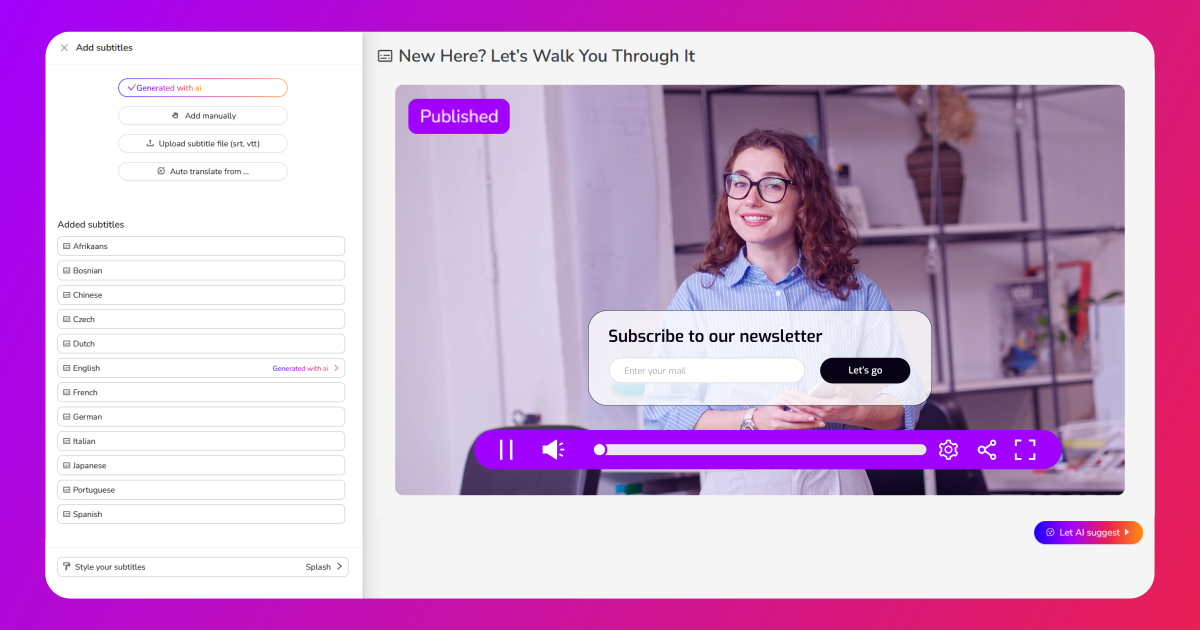What are multi-language subtitles and closed captions?
Multi-language subtitles and closed captions make video content accessible, inclusive, and understandable across languages and audiences. By displaying translated dialogue or descriptive text on-screen, they ensure that viewers can follow along regardless of language, environment, or hearing ability. This approach extends reach, improves comprehension, and aligns with accessibility standards, making it essential for global brands, educators, and organisations distributing video content worldwide.
Definition of multi-language subtitles and closed captions
Multi-language subtitles and closed captions allow viewers to follow video content in their preferred language or with visual text support. Core features include:
- Subtitles: Provide translated on-screen text matching the spoken dialogue.
- Closed captions: Include both dialogue and sound cues for accessibility.
- Multi-language support: Offer multiple translation options for global audiences.
- Automated syncing: Align captions accurately with timing and pacing.
- Customisable display: Allow viewers to adjust text appearance and placement.

Why do multi-language subtitles and closed captions matter?
Subtitles and captions make content inclusive and accessible, extending its value to a variety of languages and audience groups. They help brands reach new regions, comply with accessibility standards, and support users who prefer to watch videos without sound.
Multi-language subtitles also enhance discoverability by adding readable text for indexing and translation, improving search relevance across languages. Many of the same principles apply to content localisation, where measuring audience relevance drives engagement and inclusivity.
What are the benefits of multi-language subtitles and closed captions?
The benefits of multi-language subtitles include improved accessibility, global reach, and user experience. Subtitles help non-native speakers engage with content more easily, while closed captions provide inclusion for viewers with hearing impairments.
From a performance perspective, hosting videos with captions through a reliable video hosting platform ensures fast, accurate playback across devices, while integration with tools for content creation can help to deliver flexible, brand-aligned captioning experiences that adapt to audience preferences.
Applications of multi-language subtitles and closed captions
Subtitles and captions are widely used across industries to make content more inclusive and accessible.
Media companies use them to distribute films and broadcasts internationally. Educators include them in interactive training videos and e-learning materials for multilingual learners. Corporate teams rely on them for internal communications across regions.
Cinema8 provides dedicated video hosting and subtitle tools that enable creators to upload, translate, and sync caption files easily across multiple languages.
How Cinema8 uses multi-language subtitles and closed captions
Cinema8 helps brands, educators, and organisations deliver accessible, multilingual video experiences. Users can upload or auto-generate subtitles, apply translations, and customise their appearance, all within the platform’s interface.
Analytics tools track video engagement, showing how different languages perform and where viewers rely most on captions. By combining accessibility features with interactivity, Cinema8 ensures every viewer can engage meaningfully with video content, regardless of language or ability.
Book a demo to see how Cinema8 helps you add multi-language subtitles and captions that make your videos accessible, global, and compliant.